#dyula
Explore tagged Tumblr posts
Text
Mere paas lauda hota to ye taane nahi sunne padte 🙂
#'brush kiya kar warna shaadi ke time tak bohot kharab ho jayenge daant pati nahi milega'#buddhi abhi tu mere ghar me aayi hui hai aur mehmaan ko ham bura bhala nahi kehte par tere to baal noch ke buddhi ke baal jese khaunga main#mai brush karta hu dadi aapki misogynist khopdi me thoda sa bhi dimag hota to aapko pata hota ki daanto ka slightly yellow hona doesnt mean#that the person doesn't brush ek aur baar esa bola na ma naldi tod har baga dyula#second of all#bc har cheez husband ke liye karungi to job kya tera thenga lagega?#you have the capability to enrage me sooo much with such simple words#tu marti kyu nahi hai yaar you're the cause of so many of my insecurities#no one in the khandan likes you just stop naa#aur tu itni misogynistic kyu hai meri dadi tu khud ek aurat hai
2 notes
·
View notes
Text
Google Translate Expands Language Fluency with 110 New Additions, from Abkhaz to Zulu

Google Translate is expanding its language capabilities significantly, adding 110 new languages, including Manx, in its largest single expansion ever. This brings the total number of languages supported by the translation tool to 243, nearly doubling its previous count. The expansion is driven by PaLM 2, the latest iteration of Google's Pathways Language Model introduced in 2022 and enhanced with version 2 in May 2023. Google Translate has steadily broadened its language repertoire over the years. In 2008, for instance, it added Czech, a crucial addition for many, including this writer, who moved to a Czech-speaking region a decade ago. Recently, the focus has also extended to languages like Manx, spoken on the Isle of Man. This expansion, similar to a more modest increase of 24 languages in 2022, utilizes Google's Zero Shot machine translation method. Since 2016, Google Translate has employed neural network models for translation, with zero-resource training enabling the models to translate languages without exact one-to-one matching texts in the training database. This development highlights a practical application of large language models (LLMs), which some present as AI. LLMs operate on neural networks, and contrary to marketing claims about "AI accelerator chips," these are primarily specialized co-processors for faster tensor mathematics computations. Machine translation plays a crucial role in preserving and revitalizing minority languages. A notable example is Manx, which has seen a revival over the past few decades. The last native speaker, Edward "Ned" Maddrell, passed away in 1974. However, efforts to document the language through recordings and videos have preserved it. Today, there is a new generation of native Manx speakers, with children being raised by adults who learned the language as a second language. Additionally, the establishment of Bunscoill Ghaelgagh, a Manx language primary school, has further contributed to the language's resurgence. Google's recent addition of 110 languages, including Manx, marks its largest expansion ever of Google Translate. This brings the total number of languages supported by the translation tool to 243, nearly doubling its previous count. The expansion is powered by PaLM 2, the latest release of Google's Pathways Language Model introduced in 2022 and improved with version 2 in May 2023. Google Translate has been gradually expanding its language capabilities for years, a journey that began with the addition of languages like Czech back in 2008, catering to diverse linguistic needs worldwide. The comprehensive list of languages now supported by Google Translate includes Abkhaz, Acehnese, Acholi, Afar, Afrikaans, Albanian, Alur, Amharic, Arabic, Armenian, Assamese, Avar, Awadhi, Aymara, Azerbaijani, Balinese, Baluchi, Bambara, Baoulé, Bashkir, Basque, Batak Karo, Batak Simalungun, Batak Toba, Belarusian, Bemba, Bengali, Betawi, Bhojpuri, Bikol, Bosnian, Breton, Bulgarian, Buryat, Cantonese, Catalan, Cebuano, Chamorro, Chechen, Chichewa, Chinese (Simplified), Chinese (Traditional), Chuukese, Chuvash, Corsican, Crimean Tatar, Croatian, Czech, Danish, Dari, Dhivehi, Dinka, Dogri, Dombe, Dutch, Dyula, Dzongkha, English, Esperanto, Estonian, Ewe, Faroese, Fijian, Filipino, Finnish, Fon, French, Frisian, Friulian, Fulani, Ga, Galician, Georgian, German, Greek, Guarani, Gujarati, Haitian Creole, Hakha Chin, Hausa, Hawaiian, Hebrew, Hiligaynon, Hindi, Hmong, Hungarian, Hunsrik, Iban, Icelandic, Igbo, Ilocano, Indonesian, Irish, Italian, Jamaican Patois, Japanese, Javanese, Jingpo, Kalaallisut, Kannada, Kanuri, Kapampangan, Kazakh, Khasi, Khmer, Kiga, Kikongo, Kinyarwanda, Kituba, Kokborok, Komi, Konkani, Korean, Krio, Kurdish (Kurmanji), Kurdish (Sorani), Kyrgyz, Lao, Latgalian, Latin, Latvian, Ligurian, Limburgish, Lingala, Lithuanian, Lombard, Luganda, Luo, Luxembourgish, Macedonian, Madurese, Maithili, Makassar, Malagasy, Malay, Malay (Jawi), Malayalam, Maltese, Mam, Manx, Maori, Marathi, Marshallese, Marwadi, Mauritian Creole, Meadow Mari, Meiteilon (Manipuri), Minang, Mizo, Mongolian, Myanmar (Burmese), Nahuatl (Eastern Huasteca), Ndau, Ndebele (South), Nepalbhasa (Newari), Nepali, NKo, Norwegian, Nuer, Occitan, Odia (Oriya), Oromo, Ossetian, Pangasinan, Papiamento, Pashto, Persian, Polish, Portuguese (Brazil), Portuguese (Portugal), Punjabi (Gurmukhi), Punjabi (Shahmukhi), Quechua, Q'eqchi', Romani, Romanian, Rundi, Russian, Sami (North), Samoan, Sango, Sanskrit, Santali, Scots Gaelic, Sepedi, Serbian, Sesotho, Seychellois Creole, Shan, Shona, Sicilian, Silesian, Sindhi, Sinhala, Slovak, Slovenian, Somali, Spanish, Sundanese, Susu, Swahili, Swati, Swedish, Tahitian, Tajik, Tamazight, Tamazight (Tifinagh), Tamil, Tatar, Telugu, Tetum, Thai, Tibetan, Tigrinya, Tiv, Tok Pisin, Tongan, Tsonga, Tswana, Tulu, Tumbuka, Turkish, Turkmen, Tuvan, Twi, Udmurt, Ukrainian, Urdu, Uyghur, Uzbek, Venda, Venetian, Vietnamese, Waray, Welsh, Wolof, Xhosa, Yakut, Yiddish, Yoruba, Yucatec Maya, Zapotec, and Zulu. Read the full article
0 notes
Text
Ivory Coast/Côte d'Ivoire
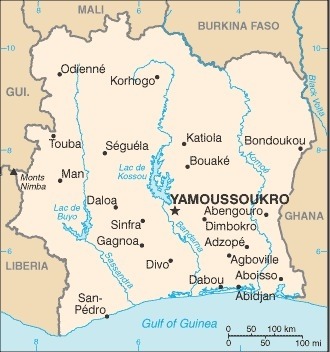
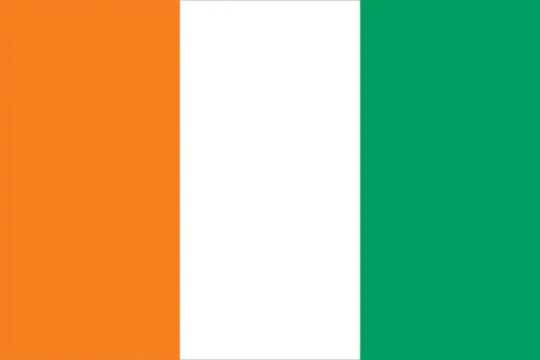
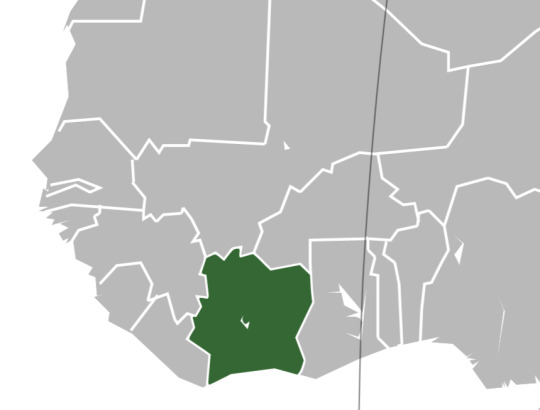
Note on the flag: The orange and green are opposite of the Irish flag, although the two are frequently confused.
Government type: Presidential Republic
President: President Alassane Ouattara (elected in 2010)
Languages: Languages of the Niger-Congo language family prevail. "Kwa in the south, Mande in the northwest, and Gur in the northeast. A trade language, known as Dyula-Taboussi and akin to the Mande Bambara, is spoken throughout the country by Muslim traders, and français de Moussa is a pidgin French widely spoken in Abidjan. The official language is French" (Encyclopedia Britannica)
Religion: Islam is the predominant religion, with Abidjan as the highest concentration. Another 40% are Christians, half of them Roman Catholics and the rest a variety of other Christian sects. Most of the remainder are irreligious.
Ethnic groups: The ethnic variety in Ivory Coast is particularly wide, and no one group forms a majority. In the modern day, the barriers between the ethnic groups have diminished and intermarriage has led to relaxed relations between them. As with many African nations, the ethnic groups do not follow the political borders, and every major ethnic group shares connections with those of the same ethnicity in neighboring countries. The predominant ethnic groups are as follows:
Akan (38%), Northern Mande (22%), Gur (22%), Kru (9.1%), Southern Mande (8.6%), and several dozen other ethnic groups make up 0.3%
The Mande were a great source of cultural influence throughout the region. Historically, this group invented West African agriculture, and were the political leaders of two major empires in Western Africa, the Soninke Empire of Ghana and the Malinke Empire of Mali (U.S. Library of Congress)
Industries:
Cereals and starchy crops (using rotational farming to preserve soil fertility), cocoa, coffee, timber (highly prized African mahogany comes from these forests as well as other species), oil and natural gas (Encyclopedia Britannica, U.S. Library of Congress)
Capital Cities:
Abidjan- located on the southern coast of the Gulf of Guinea, population 4.3 million. The de facto capital and administrative heart of the country.
Yamoussoukro- located on Lake Koussou in the center of the country, population 212k. The capital city by law because of the influence of former president Félix Houphouët-Boigny.
Currency: West African CFA franc (abbreviated XOF), colloquially called simply "francs"
Land and Environment: Ivory Coast is made up of four major regions. The coastal region is "studded with lagoons on its eastern half" (Encyclopedia Britannica). The equatorial forested area historically occupied much of the south-central region. The cultivated forests (including areas used for plantations) lies to the east. The northern savanna is sparsely populated with wide land used primarily for raising livestock. The Komoe National Park is in this northern savanna region and is a UNESCO World Heritage site.
Brief History: There is a significant gap in knowledge on early inhabitants of this land prior to the current ethnic groups. The dense rain forest also made political cohesion difficult and impractical until outside influences changed the economic needs of the inhabitants. Surrounding nations such as the Sudanic empires and traveling North African traders (who introduced Islam to the region) populated much of the area and, it is presumed, subsumed many of the indigenous ethnic groups through intermarriage. The Portuguese and French arrived in larger numbers in the 17th century, mainly using the lands as a rest-stop on their journeys to elsewhere. Thus, the Transatlantic Slave Trade had little impact on the people living there (countrystudies.us). There was a short-lived obsession with elephant ivory that ended when the elephant population declined, but nonetheless it gave the country its name, the Ivory Coast. By the 20th century, the French had subjected the Ivory Coast to economic exploitation as well as Nazist racial theories during the Vichy presidency. The French surrender in World War 2 led to a greater freedom of African thinkers, including a prominent Communist party, that eventually led to the nation's independence. During this time, Felix Houphouet-Boigny rose in prominence, was elected president, and transformed the political landscape. (countrystudies.us)
Former president Felix Houphouet-Boigny is an Ivorian person of note, and he has had the greatest influence on the modern political structure of any one man. He was the first president of the country following independence beginning in 1960, and he represented an age of economic prosperity, dubbed the Ivorian Miracle due to the economic struggles of other nations in West Africa at the time. He was politically centrist, advocating for diplomacy with France and maintaining positive relations with them while maintaining sovereignty. His political style was modeled after his Baoule elders, soft and non-confrontational yet insistent, a style which lent to his ethos as an untouchable political monolith. He also heavily emphasized primary sector industry, particularly coffee and cocoa, which allowed them to prosper within limits ("growth without development" according to his own words (Encyclopedia Universalis, via Wikipedia). This came to a head during the global recession in the 1980s, which showed many holes in his leadership, including his extravagant displays of wealth while poverty in the Ivory Coast doubled. Still, many cultural landmarks and government buildings, including the Yamoussoukro Basilica (the largest Catholic church in Africa and among the largest in the world), were commissioned by Houphouet-Boigny. Even the current president of the Ivory Coast was once Houphouet-Boigny's appointed Prime Minister.
1 note
·
View note
Text
Languages of the world
Dyula (Julakan/ߖߎ߬ߟߊ߬ߞߊ߲)
Basic facts
Number of native speakers: 6.8 million
Spoken in: Burkina Faso, Côte d’Ivoire, Mali
Script: Latin, 28 letters/N’Ko, 25 letters
Grammatical cases: 0
Linguistic typology: agglutinative, SVO
Language family: Mande, Western Mande, Manding-Kpelle, Central Mande, Manding-Jogo, Manding-Vai, Manding-Mokole, Manding, East Manding
Number of dialects: -
History
1949 - invention of the N’Ko script
1973 - the Latin alphabet is adapted for Dyula
Writing system and pronunciation
These are the letters that make up the Latin script: a b c d e ɛ f g h i j k l m n ɲ ŋ o ɔ p r s t u v w y z.
These are the letters that make up the N’Ko script: ߊ ߋ ߌ ߍ ߎ ߏ ߐ ߓ ߔ ߕ ߖ ߗ ߘ ߚ/ߙ ߛ ߜ ߝ ߞ ߟ ߡ ߢ ߣ ߤ ߥ ߦ.
Although the Latin alphabet is the only official script, N’Ko is still in use.
There are two tones: high and low. However, they are not usually marked in writing.
Grammar
Nouns have two numbers (singular and plural). Gender can be marked by adding a suffix.
Postpositions are used to express direction, location, and possession.
Verbs are not conjugated per se, but tense and affirmation and negation are expressed using markers. Transitive and intransitive verbs have different conjugations.
Dialects
There seems to be no dialectal variation.
6 notes
·
View notes
Text

▪︎Do Muso Mask.
Date: late 18th-late 19th century
Place of origin: Côte d'Ivoire, Africa
Culture: Dyula
Medium: Pewter, brass, copper
#18th century#18th century art#18th century mask#ethnic#ethnic mask#ethnic art#do muso mask#côte d'ivoire#africa#african#dyula#pewter#brass#copper#history
36 notes
·
View notes
Link
Le dioula, Parfois écrit jula ou bien dyula, est une langue mandingue parlée ou comprise par environ 20 millions de personnes au Mali, en Côte d'Ivoire et au Burkina Faso...Découvrez son histoire ici .
0 notes
Text
African Languages With Non Latin Alphabets?
vimeo
So after seeing a tweet by Montel informing everyone that the Yoruba language now unofficially has a written non-Latin syllabary (I kept saying syllabus in the video by mistake) to compliment the oral language I was intrigued.
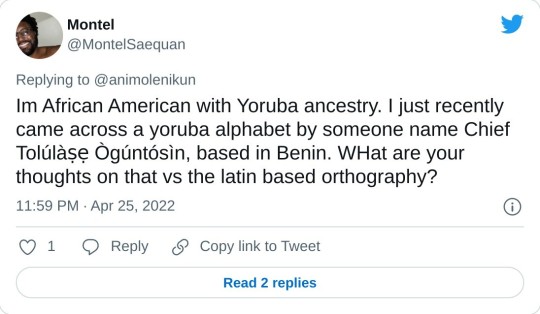
Note: here is the audio version of my reaction via SoundCloud:
I remember being informed that the Fulani (aka Fula) & Kpelle had similar syllabaries so I was very excited to discover that Yoruba had one too.
After further research I discovered that most of the African tribes I am related to have their own syllabary. All of them except Temne developed their own non-Latin written language.
A website called Omniglot catalogues these languages (as well as many around the world) so all I had to do is visit the Omniglot search page, type in my various tribes & become reintroduced to a world I never knew existed.
So here is what I discovered (I encourage everyone to visit Ominiglot for more details about the origins & history of each syllabary).
Yoruba: Odùdwà Alphabet
The Odùduwà alphabet was invented by Chief Tolúlàṣẹ Ògúntósìn from Benin as a way to write the Yoruba language. He claims that he was inspired to create the alphabet in dreams between 2011 and 2016. He also believes that the alphabet was used back in the 12th century by King Odùduwà, who is regarded as the father of the Yoruba people, and was then lost. (Omniglot.com)

Kpelle: Kpelle Syllabary
The Kpelle syllabary was invented during the 1930s by Chief Gbili of Sanoyea in Bong County in Liberia. He was apparently inspired to create it in a dream. It was used by a number of Kpelle chiefs, their scribes and a few others. They used it to write messages, keep records of taxes, stores and debts, and to write a recipe book. Very little of this material survives because of the civil wars in Liberia. It was used at least until the 1980s. (Omniglot.com)

Fula (aka Fulani): Adlam
The Adlam alphabet was created in the 1980s by Ibrahima and Abdoulaye Barry, two brothers from Guinea who decided that their language, Fulani, needed its own alphabet. The name of the alphabet comes from the first four letters, A, D, L, and M. (Omniglot.com)

Mende: Mende Syllabary (Kikakui)
The Mende syllabary was invented in 1921 by Kisimi Kamara (ca. 1890-1962) of Sierra Leone. Seeing how the British managed to take over his country, Kisimi concluded that their power was partly a result of their literacy. He decided to give his own people that ability. Kisimi claimed he was inspired in a dream to create the Mende syllabary, which he called Ki-ka-ku. During the 1920s and 1930s he ran a school in Potoru to teach Ki-ka-ku. The syllabary became a popular method of keeping records and writing letters. (Omniglot.com)

Mandinka: N’Ko
The N'Ko alphabet was invented by Soulemayne Kante of Kankan, Guinea, in 1949. It is mainly used by speakers of Maninka, Bambara, Dyula and their dialects in Guinea, Côte d'Ivoire and Mali. (Omniglot.com)

Although I was disappointed to not discover a Temne Syllabary, I did find out that the Igbo people (I have friends who are Igbo) did have a Syllabary of their own (albeit with a certain dialect).
Igbo: Nwagụ Aneke
The Nwagụ Aneke Script is a syllabary for the Umuleri dialect of Igbo. It was developed in late 1950s by Ogbuevi Nwagụ Aneke, an illiterate land owner and diviner from Umuleri, a village in Anambra State in the southeast of Nigeria. He claimed that spirits of his ancestors revealed the symbols to him. (Omniglot.com)

There are many other African tribes with the own Syllabaries, although unfornately they have faced aggressive resistance from African governments (odd but true) or colonial powers who feared a cultural separation.
I wonder what it would take to revive these languages via written form‽ Hmm…
#africa#african ancestry#yoruba#igbo#kpelle#mandinka#fulani#mende#temne#languages#language#african languages#african#Vimeo#SoundCloud
9 notes
·
View notes
Photo





N'Ko (N'Ko: ߒߞߏ) is a script devised by Solomana Kante in 1949, as a writing system for the Manding languages of West Africa.The term N'Ko, which means I say in all Manding languages, is also used for the Manding literary standard written in N'Ko script.
The script has a few similarities to the Arabic script, notably its direction (right-to-left) and the letters which are connected at the base. Unlike Arabic, it obligatorily marks both tone and vowels. N'Ko tones are marked as diacritics, in a similar manner to the marking of some vowels in Arabic.
History
Grave of Kanté Souleymane. The French at the bottom reads "Inventor of the N'Ko alphabet".
Kante created N'Ko in response to what he felt were beliefs that Africans were a culture-less people, because before then, no indigenous African writing system for his language existed. N'Ko was invented in Bingerville, Côte d'Ivoire and then brought to Kante's natal region of Kankan, Guinea before being disseminated into other Manding-speaking parts of West Africa. N'Ko Alphabet Day is April 14, relating to the date in 1949 when the script is believed to have been finalized.
The introduction of the script led to a movement promoting literacy in the N'Ko script among Manding speakers in both Anglophone and Francophone West Africa. N'Ko literacy was instrumental in shaping the Maninka cultural identity in Guinea, and it has also strengthened the Manding identity in other parts of West Africa.

Current use
As of 2005, it is used mainly in Guinea and the Ivory Coast (respectively by Maninka and Dyula speakers), with an active user community in Mali (by Bambara-speakers). Publications include a translation of the Quran, a variety of textbooks on subjects such as physics and geography, poetic and philosophical works, descriptions of traditional medicine, a dictionary, and several local newspapers. It has been classed as the most successful of the West African scripts.
N'Ko literature generally uses a literary language register, termed kangbe (literally, 'clear language'), that is seen as a potential compromise dialect across Manding languages.For example, the word for 'name' in Bamanan is tɔgɔ and in Maninka it is tɔɔ. In written communication each person will write it one single way in N'Ko, and yet read and pronounce it as in their own language. This literary register is thus intended as a koiné language blending elements of the principal Manding languages, which are mutually intelligible, but has a very strong Maninka flavour.
There has also been documented use of N'Ko, with additional diacritics, for traditional religious publications in the Yoruba and Fon languages of Benin and southwestern Nigeria.

Letters
The N'Ko script is written from right to left, with letters being connected to one another
#african writing systems#african culture#african#kemetic dreams#n'ko#west africa#african writing#handwriting
138 notes
·
View notes
Text
Tiéfo
Endangered Languages Challenge 6/7

What’s the language called?
Tiéfo, Cɛfɔ, Foro, Tyefo, Tyeforo, Kiefo, Tiefo
What linguistic family does it belong to?
Niger-Congo, Atlantic-Congo, North Volta-Congo, Gur. There are two related but mutually unintelligible languages: Tiefo-N (for Nyafogo where it’s spoken) and Tiefo-D (for Daramandougou where it’s spoken). They’re apparently Gur languages but their relation to any other languages is unclear.
Where is it spoken?
Burkina Faso, in the northern Comoe and southern Houet Provinces.

What’s the situation for the language and speaker community?
It seems to depend on the individual geographic community.
Along with the language, Tiefo culture overall is considered to be endangered. Many of the Tiefo now speak Dyula and learn French in school, and aren’t necessarily passing on the Tiefo language to younger generations.

"It is said that the Tiéfo are endangered, because a people without language is an unarmed soldier. Otherwise we are there but as we do not understand our language, that's why we say we are endangered.” - Felix Ouattara (pictured above)
In a 2001 sociolinguistic report on Tiefo, in Dramandougou specifically, six of ten of the respondents stated that young people speak Tiéfo most of the time, and that children speak it with each other, which seems encouraging. However, it’s not the language used in education (which is either Dyula or French), which limits the contexts in which they will be able to use Tiefo later on in life. Adults speak the language with each other, but can’t get by without speaking at least some Dyula.
The report also mentions that the Tiefo in Dramandougou have very strong feelings about their language, and are very concerned about its endangerment. Respondents indicated that they’d prefer to have the option to learn to read and write in Tiefo, and they unanimously agreed that traditional ceremonies and stories are best in Tiefo.
Does it have any official or legal status?
Not as far as I’ve found. French is the official language, and Mossi/Móorè, Dyula, and Fulfulde are considered national languages in Burkina Faso.
What’s its documentation status?
Tiefo’s grammar has been documented, but mainly by outsiders. I wasn’t able to find whether there are teaching materials in the language or whether speakers have access to resources in their language. Given everything else I read, it seems unlikely, though.
Sources and resources: https://www.sil.org/system/files/reapdata/67/27/48/67274852587554948301483132302180825127/SILESR2002_006.pdf http://www.endangeredlanguages.com/lang/3818 https://en.wikipedia.org/wiki/Tyefo_language https://joshuaproject.net/assets/media/profiles/text/t15477.pdf https://dogonlanguages.org/other#tiefo http://www.fasozine.com/actualite/culture/3810-le-peuple-tiefo-un-groupe-ethnique-en-voie-de-disparition-au-burkina.html https://www.burkina24.com/2018/04/11/le-tiefo-une-identite-culturelle-en-peril/ http://burkina.cascades.over-blog.com/article-le-village-de-dramandougou-dernier-locuteur-de-la-langue-tiefou-72165635.html
58 notes
·
View notes
Photo

Dyula woman's head tie, 1940s-60s, Guinea, West Africa.
9 notes
·
View notes
Photo

Praying for Odienne Jula in Cote d'lovire @unreached_peoples . . . #unreachedpeoplegroups #unreached #salvation #Jesussaves #prayer #pray #intercession #raptureready #jesusiscoming #christianlife #bodyofchrist #hopeforthenations #narrow #odienne #jula #cotedlvoire #africa #Muslim #Islam #wojenaka #spiritist #dyula #clan https://www.instagram.com/p/CdEIh_hJfyA/?igshid=NGJjMDIxMWI=
#unreachedpeoplegroups#unreached#salvation#jesussaves#prayer#pray#intercession#raptureready#jesusiscoming#christianlife#bodyofchrist#hopeforthenations#narrow#odienne#jula#cotedlvoire#africa#muslim#islam#wojenaka#spiritist#dyula#clan
0 notes
Link
"Desde siempre los dyula malinke, son los reyes de este imperio, donde hacen creer que lo son los senufo." #SociedadSenufo #elporo #EsclavitudSenufo #nergba #laSakrobundi #lossenufo #africa #pueblosdeafrica
0 notes
Text
Discovering the world
Burkina Faso 🇧🇫
Basic facts
Official name: Burukina Faso/Burkina Faso/Burkĩna Faso (Dyula/Fula/Mooré)
Capital city: Ouagadougou
Population: 22.4 million (2023)
Demonym: Burkinabè
Type of government: unitary republic
Head of state: Ibrahim Traoré (President)
Head of government: Apollinaire Joachim Kyélem de Tambèla (Prime Minister)
Gross domestic product (purchasing power parity): $62.78 billion (2023)
Gini coefficient of wealth inequality: 38.9% (medium) (2020)
Human Development Index: 0.438 (low) (2022)
Currency: West African CFA franc (XOF)
Fun fact: It hosts the largest African film festival.
Etymology
“Burkina” comes from Mooré and means “upright”, while “Faso” comes from Dyula and means “fatherland”, so the country’s name means “land of the honest men”.
Geography
Burkina Faso is located in West Africa and borders Niger to the northeast, Benin to the southeast, Togo and Ghana to the south, Côte d’Ivoire to the southwest, and Mali to the northwest.

There are three climates: hot desert in the north, hot steppe in the center, and tropical savanna in the south. Temperatures range from 16 °C (60.8 °F) in winter to 39 °C (102.2 °F) in summer. The average annual temperature is 21.9 °C (71.4 °F).

The country is divided into thirteen regions (marabolow/ɗereeji/tẽnsa), which are further divided into 45 provinces (mara/diiwanuuji/provense). The largest cities in Burkina Faso are Ouagadougou, Bobo-Dioulasso, Koudougou, Banfora, and Ouahigouya.

History
3rd-13th centuries: Bura culture
15th century-1896: Mossi Kingdoms
1710-1898: Kong Empire
1919-1932: Upper Volta
1932-1947: Colony of Niger
1947-1958: Upper Volta
1958-1984: Republic of Upper Volta
1984-present: Burkina Faso
1985: Agacher Strip War
2014: uprising
2022: coups d’état
Economy
Burkina Faso mainly imports from Côte d’Ivoire, Pakistan, and Ghana and exports to Benin, Togo, and Japan. Its top exports are gold, cotton, and sesame seeds.
The majority of the population relies on subsistence agriculture. Services represent 44.9% of the GDP, followed by agriculture (31%) and industry (23.9%).

Burkina Faso is a member of the Community of Sahel-Saharan States, la Francophonie, and the Organization of Islamic Cooperation.
Demographics
Mossi people represent 53.7% of the population, followed by the Fulani (6.8%), Gurunsi (5.9%), Bissa (5.4%), Gurma (5.2%), Bobo (3.4%), Senufo (2.2%), Bissa (1.5%), and Lobi (1.5%). The main religion is Islam, practiced by 63.8% of the population, the majority of which is Sunni.

It has a negative net migration rate and a fertility rate of 4.2 children per woman. 31.9% of the population lives in urban areas. Life expectancy is 63.44 years and the median age is 17.9 years. The literacy rate is 41.2%.
Languages
The official languages of the country are Bissa, Dyula, Fula, and Mooré, spoken by 3.2%, 5.7%, 9.3%, and 40.5% of the population, respectively. The working language is French, but less than 15% of the population uses it on a daily basis.
Culture
Two key elements of Burkinabè culture are indigenous masks used in sacrifice rites and dancing. Spirituality is very important for the Burkinabè.
Men wear a cotton shirt and pants (kurug). Women wear a colorful top and a long, cotton skirt.

Architecture
Traditional houses in Burkina Faso are round and made of mud and clay with thatched roofs. They sometimes feature geometric patterns on the walls.

Cuisine
The Burkinabè diet is based on beans, corn, sorghum, potatoes, rice, and vegetables. Typical dishes include babenda (a stew of fermented beans, fish, cabbage, and/or spinach), banfora (puffed pancakes with cinnamon, pineapple, and sugar), ragout d’igname (a yam stew), riz gras (rice with meat, onions, and tomatoes), and tô (polenta-style cakes served with a vegetable sauce).

Holidays and festivals
Like Christian and Muslim countries, Burkina Faso celebrates Easter Monday, Ascension Day, Assumption Day, All Saints’ Day, Christmas Day, Eid al-Fitr, Eid al-Adha, and Mawlid. It also commemorates New Year’s Day, International Women’s Day, and Labor Day.
Specific Burkinabè holidays include Revolution Day on January 3, which celebrates the 1966 coup d’état; Day of Customs and Traditions on May 15; Independence Day on August 5; Martyrs’ Day on October 31, dedicated to the victims of the 2015 failed coup, and Proclamation of Independence Day on December 11.

Day of Customs and Traditions
Other celebrations include the Mask and Arts Festival and the National Culture Week.

Mask and Arts Festival
Landmarks
There are three UNESCO World Heritage Sites: Ancient Ferrous Metallurgy Sites of Burkina Faso, Ruins of Loropéni, and W-Arly Pendjari Complex, a transnational group of three national parks.

Ruins of Loropéni
Other landmarks include the Bobo-Dioulasso Grand Mosque, the Bourzanga necropolis, the Douna Caves, the Sindou Peaks, and the Tengrela Falls.

Bobo-Dioulasso Grand Mosque
Famous people
Apolline Traoré - movie director
Bil Aka Kora - musician
Diébédo Francis Kéré - architect
Georgie Badiel - model
Jacky Ido - actor and director
Joris Bado - basketball player
Monique Iboudo - activist and writer
Odile Sankara - artist and actress
Philomaine Nanema - comedian
Thomas Sankara - military officer

Monique Iboudo
You can find out more about life in Burkina Faso in this website and this video.
5 notes
·
View notes
Text
Дьюла Силади
Дьюла Силади

Ансамбль старинной музыки «Трио-Соната» в составе: Заслуженный артист России ВладимирСкляренко (гобой); Лауреат международных конкурсов Елена Лельчук (клавесин, фортепиано); Людмила Домбровски (виолончель) Лауреат международных конкурсов Аида Мурадя
Читайте полностью на сайте CityGu.Ru https://citygu.ru/afisha_saratov/dyula-siladi
Еще больше интересного в Саратове на сайте Саратов. CityGu.Ru. Интеллектуально -развлекательный портал http://citygu.ru
0 notes
Photo

Flag of Burkina Faso
Aspect Ratio 2:3
The flag of Burkina Faso was adopted in 1984. In 1958 the colony of French Upper Volta achieved independence, but was still a member of the French Community. Several attempted coups occurred during this period, and in 1983 a popularly supported coup d'état resulted in the leader of the leftist faction, Thomas Sankara, coming to power. Sankara renamed the country Burkina Faso, a name derived from the Mossi and Dyula languages, roughly meaning "Land of Incorruptible People." A new flag was implemented in 1984 to replace the Upper Volta flag. The Burkinabé flag incorporates the Pan-African color scheme as laid out in the Ethiopian flag, reflecting a break with colonialism and unity with other African ex-colonies. The red and green are also said to signify revolution and natural riches respectively. The central star is the guiding light of the revolution.
x.x.x.x.
1 note
·
View note
Photo



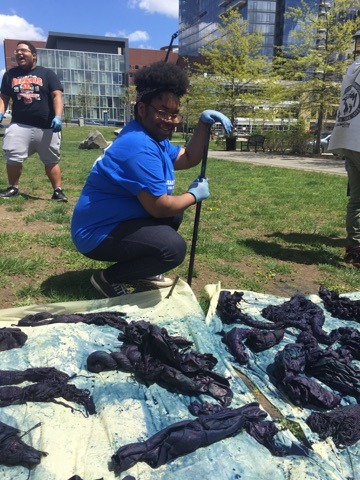






Hello everyone! This past week our team dyed the Adire and yarns we have been preparing over the last month. All the hours of tying and stitching culminated with us dyeing using indigo and Guinea Corn leaves (Oka Baba). We were blessed with perfect weather and some beautifully dyed Items that will be incorporated into the final installation. The pieces incorporated dyeing techniques from all over west Africa including “Adire Alabere” (stitch resist) techniques from Nigeria. “Gara” kola nut and Indigo over dyeing techniques from Gambia and Sierra Leone and over dyed tie and dye handwoven textiles drawn from Dyula and Baule textiles from the Ivory coast. Stay tuned as our project continues to develop!
#adire#africantextiles#texileart#handwoven#handdyed#indigo#kolanut#naturaldyes#blackexcellence#youthwork#publicart#ancestry in progress#yoruba#nigeria#gambia#ivory coast#asoofi#art on tumblr
92 notes
·
View notes